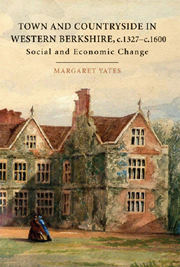Book contents
- Frontmatter
- Contents
- List of tables, figures, and maps
- Acknowledgements
- Abbreviations
- Sums of money
- 1 The end of the Middle Ages?
- 2 Landscapes, population and wealth in western Berkshire from the fourteenth to the sixteenth century
- 3 Town and country relations: Newbury and its hinterland
- 4 Estate management and profitability
- 5 Tenant society
- 6 Conclusion: the chronology of change
- Appendices
- Bibliography
- Index
3 - Town and country relations: Newbury and its hinterland
Published online by Cambridge University Press: 05 February 2013
- Frontmatter
- Contents
- List of tables, figures, and maps
- Acknowledgements
- Abbreviations
- Sums of money
- 1 The end of the Middle Ages?
- 2 Landscapes, population and wealth in western Berkshire from the fourteenth to the sixteenth century
- 3 Town and country relations: Newbury and its hinterland
- 4 Estate management and profitability
- 5 Tenant society
- 6 Conclusion: the chronology of change
- Appendices
- Bibliography
- Index
Summary
Introduction
Urban–rural relationships are an important dynamic in any study of past societies and economies. It is readily accepted among historians that towns can be defined simply as a relatively dense and permanent concentration of residents engaged in a multiplicity of activities, a substantial proportion of which were non-agrarian. This definition, however useful, isolates the town and omits the relationship with its immediate surrounding countryside, with other towns, and its place within a market network. Towns fulfilled essential social and economic functions that inextricably bound them into a series of both local and wider relationships. Geographers and archaeologists have developed theoretical approaches to their analyses of towns. In particular, they model towns in terms of central place theory, spheres of influence, urban hierarchies and marketing systems. These conceptual frameworks are not without problems, especially as they have a tendency to become static and mechanical models, but they do perform a useful function in rationalising our analysis of the function of towns and the nature of urban–rural relationships and are summarised here to proved a context for the study of a specific town.
Towns can be conceived within a hierarchy based on size, economic function and social complexity. Central place theory is employed by geographers as a method for defining and quantifying towns, and then ranking them by their function. Every town possesses a distinctive role in that, to some degree, it acts as a focus for the surrounding countryside and operates as a central place for collecting and distributing local produce; at the same time providing the goods and services that the countryside requires.
- Type
- Chapter
- Information
- Town and Countryside in Western Berkshire, c.1327–c.1600Social and Economic Change, pp. 67 - 124Publisher: Boydell & BrewerPrint publication year: 2007

